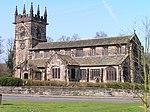St Bartholomew's Church, Wilmslow
Church of England church buildings in CheshireDiocese of ChesterEnglish Gothic architecture in CheshireGothic Revival architecture in CheshireGothic Revival church buildings in England ... and 2 more
Grade I listed churches in CheshireWilmslow

St Bartholomew's Church is in the town of Wilmslow, Cheshire, England. The church is recorded in the National Heritage List for England as a designated Grade I listed building. It is an active Anglican parish church in the diocese of Chester, the archdeaconry of Macclesfield and the deanery of Knutsford.
Excerpt from the Wikipedia article St Bartholomew's Church, Wilmslow (License: CC BY-SA 3.0, Authors, Images).St Bartholomew's Church, Wilmslow
Chancel Lane,
Geographical coordinates (GPS) Address External links Nearby Places Show on map
Geographical coordinates (GPS)
| Latitude | Longitude |
|---|---|
| N 53.3301 ° | E -2.2296 ° |
Address
St. Bartholomew's church
Chancel Lane
SK9 1BA , Wilmslow Park
England, United Kingdom
Open on Google Maps









